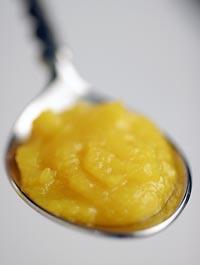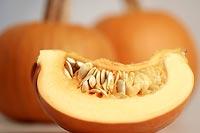Sugar pumpkins a pie-maker's treat

You may not notice them at first, overshadowed as they are by the hulking presence of jack-o'-lanterns. Either sitting on farmers' market tables, sequestered in the produce department of your local supermarket or tucked alongside the orange mountain that appears in front of markets are the sweetly shaped sugar pumpkins.
"This small gem predates the Civil War and has earned a reputation as perhaps the best all-round pumpkin," writes Roger Vepsen in "A Celebration of Heirloom Vegetables."
The flavor of sugar pumpkins is sweeter and their texture smoother than the jack-o'-lantern. According to the FDA, jack-o'-lanterns are safe to eat, but for baking purposes their stringy texture doesn't make the silkiest purée.
Pies made with fresh pumpkin have a lighter texture and color, and a more delicate, squashlike flavor, while those made with concentrated canned pumpkin are denser and more intensely flavored, with a deeper color. In "Macrina Bakery & Cafe Cookbook," author and pastry chef Leslie Mackie combines the two — fresh and canned — for a pie that tastes fresh, rich and spicy.
If your curiosity has been tweaked about experimenting with fresh pumpkin, there are a few steps to take care of before the meat is ready for pies, muffins or soups.
The first is literally the toughest. It's not hubris when Martha Stewart, the most consummate pumpkin carver, suggests using keyhole saws and wood gouges on the tough skin. Removing the shell of any pumpkin requires plenty of muscle strength. But when the goal is to use the meat for cooking, the job is made easier once the pumpkin has been softened through cooking.
Roasting: First wash the pumpkin. Using a sharp chef's knife, make a shallow cut from stem to blossom end on opposite sides. (Don't try to cut through the stem.) Continue to cut into the pumpkin slowly until the two sides begin to divide, then cut all the way through the blossom end. Pull off the stem and scoop out the seeds with a large spoon. Cut the pumpkin halves crosswise in half again.
Place pumpkin pieces in a large rimmed baking sheet or roasting pan. Add 1 ½ cups water and roast in a preheated 375-degree oven, uncovered, about 1 to 1 ½ hours. The squash should be very tender. Remove pan from oven and transfer pieces to a cutting surface to cool for about 20 minutes.
Whole sugar pumpkins can also be roasted in the oven. With a sharp paring knife, pierce shell in a couple of places. Place the pumpkin on a baking pan set on the bottom rack of a preheated 350-degree oven. (The remaining racks should be removed.) The cooking time will vary, but plan on at least 2 hours for a 4-pound pumpkin or until the flesh can be easily penetrated with a knife.
Purée: Once the pumpkin meat is tender, it's easy to scrape it off the shell with a large spoon. Use a food processor and purée the pumpkin in small batches so it's completely smooth. A sugar pumpkin weighing about 4 pounds makes about 1 ½ to 2 cups purée.
Fresh pumpkin purée will be much looser than concentrated canned pumpkin. Some of the liquid will need to be strained off or evaporated before it can be used for baking, where the balance between wet and dry ingredients is critical.
There are a couple of ways to do that. Liquid that pools on the top of the cooled purée should be spooned off. Then line a strainer with several layers of cheesecloth, set over a bowl and add cooled purée. Cover with plastic wrap, refrigerate overnight and let the water drip out of the purée.
A recipe for baked apple butter led to the idea of concentrating the pumpkin purée in the oven. Spread 2 ½ cups purée in a 7-by-11-inch baking pan and place in a preheated 275-degree oven. Bake 40 minutes, stirring once or twice, until reduced by about half. Cool before using. This is a great method to use in muffins or quick breads where the batter can become too heavy and take too long to bake through.
Don't be tempted to increase the spices in a sugar pie filling too much to compensate for the delicate flavor. If you're beginning with a traditional recipe, adding an additional 1/8 teaspoon of each spice will complement the subtleties of the fresh pumpkin without destroying it.
Fresh pumpkin purée can be refrigerated up to 3 days or frozen up to 5 months. Defrost in the refrigerator the day before using and drain through a cheesecloth-lined sieve, in the refrigerator, after defrosting.
CeCe Sullivan: csullivan@seattletimes.com


